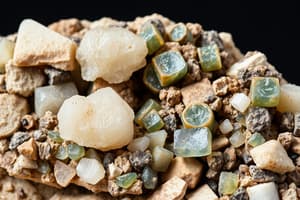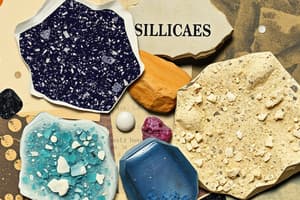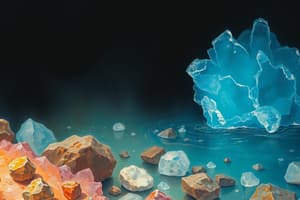Podcast
Questions and Answers
To be a mineral, a substance must be?
To be a mineral, a substance must be?
naturally occurring, a solid, inorganic, and have a definite chemical composition
What are the two main classes of minerals?
What are the two main classes of minerals?
Silicate and Non silicate
What is an example of silicate?
What is an example of silicate?
Quartz
What is an example of a Non silicate?
What is an example of a Non silicate?
Silicates have what?
Silicates have what?
Quartz and feldspar are....
Quartz and feldspar are....
Non Silicates don't contain?
Non Silicates don't contain?
What makes up 50% of the crust?
What makes up 50% of the crust?
What are some facts about Silicon?
What are some facts about Silicon?
Ionic is when?
Ionic is when?
What is a single chain?
What is a single chain?
What is a double chain?
What is a double chain?
What is a sheet?
What is a sheet?
What is network?
What is network?
What are the types of non silicates?
What are the types of non silicates?
What are Oxides made up of?
What are Oxides made up of?
What are sulfides made up of?
What are sulfides made up of?
What are Halides made up of?
What are Halides made up of?
What are sulfates made up of?
What are sulfates made up of?
What are carbonates made up of?
What are carbonates made up of?
What does an 'ate' ending mean?
What does an 'ate' ending mean?
What are Native elements made up of?
What are Native elements made up of?
What are the mineral properties?
What are the mineral properties?
Easy to test BUT the same mineral can have different.....?
Easy to test BUT the same mineral can have different.....?
Different minerals can be the same color
Different minerals can be the same color
Defined as the color of the powdered form of the mineral
Defined as the color of the powdered form of the mineral
What are some more mineral properties?
What are some more mineral properties?
Breaks in straight lines?
Breaks in straight lines?
DOES NOT break into straight lines?
DOES NOT break into straight lines?
Resistance to scratching; compare to minerals on MOH's hardness scale.
Resistance to scratching; compare to minerals on MOH's hardness scale.
How heavy it is for its size?
How heavy it is for its size?
Sparks when hit?
Sparks when hit?
Even more mineral properties....
Even more mineral properties....
Attracts a magnet?
Attracts a magnet?
Glows under ultraviolet light?
Glows under ultraviolet light?
The crystal splits light to see a double image?
The crystal splits light to see a double image?
Atoms in the mineral break down releasing radiation.
Atoms in the mineral break down releasing radiation.
Can you taste test rocks?
Can you taste test rocks?
What are the two main groups of minerals?
What are the two main groups of minerals?
Which two elements are most commonly found in minerals?
Which two elements are most commonly found in minerals?
Are carbonates and halides silicate or non silicate minerals?
Are carbonates and halides silicate or non silicate minerals?
Flashcards are hidden until you start studying
Study Notes
Definition of Minerals
- Minerals must be naturally occurring, solid, inorganic, and have a definite chemical composition.
Main Classes of Minerals
- Two primary classes are Silicate and Non-silicate.
Examples of Minerals
- Silicate example: Quartz
- Non-silicate example: Halite
Composition of Silicates
- Silicates are composed of Silicon and Oxygen.
Common Minerals
- Quartz and feldspar are the most common minerals found in the Earth's crust.
Characteristics of Non-silicates
- Non-silicates do not contain Silicon.
Crust Composition
- Quartz and feldspar make up approximately 50% of the Earth’s crust.
Silicon Facts
- Silicon combines with oxygen to form a tetrahedron structure, consisting of one silicon atom surrounded by four oxygen atoms.
Mineral Structures
- Ionic bonding occurs when tetrahedrons are not touching.
- Single chains of tetrahedra connect in a line.
- Double chains form when two single chains link together.
- Sheets are formed when chains connect to create flat layers.
- Networks have tetrahedra connected in all directions.
Types of Non-silicates
- Non-silicates include Oxides, Sulfates, Sulfides, Halides, Carbonates, and Native elements.
Non-silicate Composition
- Oxides: Metal + Oxygen
- Sulfides: Metal + Sulfur
- Halides: Metal + Halogen (Salts)
- Sulfates: Metal + Sulfur + Oxygen
- Carbonates: Metal + Carbon + Oxygen
- Native elements consist of a single type of atom.
Mineral Properties
- Key properties include Color, Streak, Crystal Shape, Cleavage, Fracture, Hardness, and Density.
- Color can vary significantly among different minerals.
- Streak is the color of a mineral in powdered form.
More on Mineral Properties
- Cleavage refers to breaking in straight lines.
- Fracture describes irregular breaking patterns, such as conchoidal fracture in quartz.
- Hardness measures resistance to scratching on the Mohs hardness scale.
- Density indicates how heavy a mineral is for its size.
Additional Properties
- Some minerals exhibit piezoelectricity, generating sparks when struck.
- Magnetism refers to minerals that attract magnets.
- Fluorescence occurs when minerals glow under ultraviolet light.
- Double Refraction is the splitting of light that produces a double image.
- Radioactivity involves the breakdown of atoms releasing radiation.
Unique Testing
- Taste testing can identify certain rocks.
Common Elements in Minerals
- The two most commonly found elements in minerals are Oxygen and Silicon.
Non-silicate Mineral Classification
- Non-silicate minerals, which constitute about 4% of the Earth’s crust, are divided into six major groups based on their chemical composition.
Studying That Suits You
Use AI to generate personalized quizzes and flashcards to suit your learning preferences.




